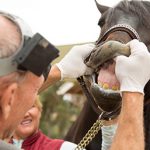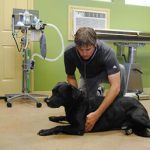Periodontal disease is the most common clinical condition occurring in adult dogs and cats, and is entirely preventable. By three years of age, most dogs and cats have some evidence of periodontal disease. Unfortunately, other than bad breath, there are few signs of the disease process evident to the owner, and professional dental cleaning and periodontal therapy often comes too late to prevent extensive disease or to save teeth. As a result, periodontal disease is usually under-treated, and may cause multiple problems in the oral cavity and may be associated with damage to internal organs in some patients as they age.
Periodontal disease begins when bacteria in the mouth form a substance called plaque that sticks to the surface of the teeth. Subsequently, minerals in the saliva harden the plaque into dental calculus (tartar), which is firmly attached to the teeth. Tartar above the gum line is obvious to many owners, but is not of itself the cause of disease.
Bacteria from the mouth can enter the bloodstream and are carried around the body. Studies in dogs have shown that periodontal disease is associated with microscopic changes in the heart, liver, and kidneys.











